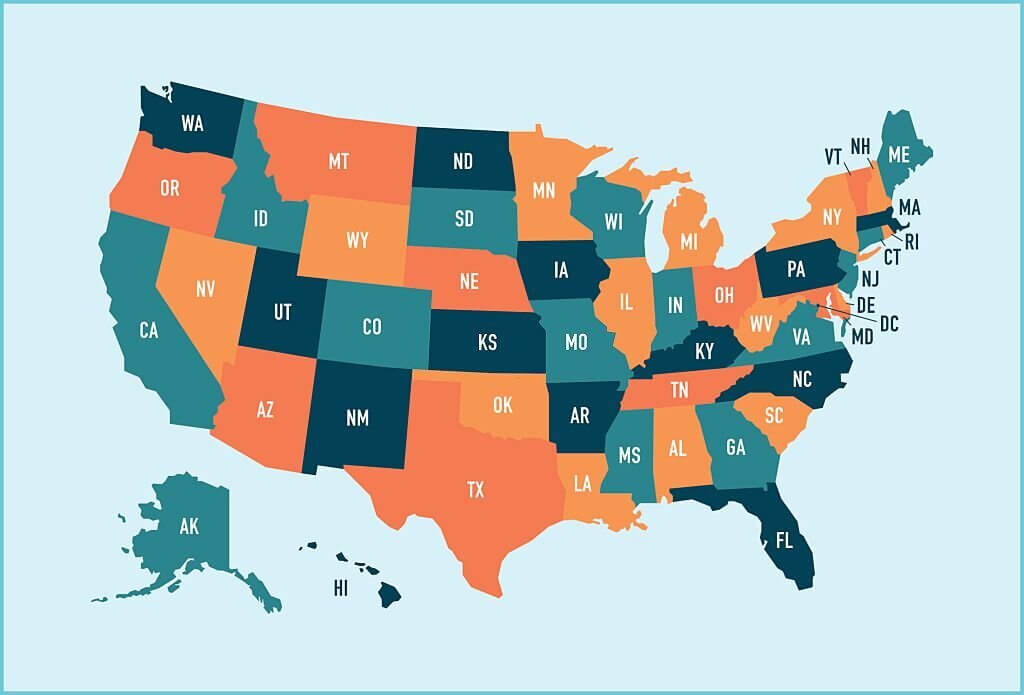Utilities are a part of everyday life, and they make sure that your home works well and is still comfortable and livable. People who own homes, rent, and even rent can spend a lot of money on utilities. If you are planning to shift to the USA for any reason then you must research properly about the utilities cost in the USA otherwise it may trouble you for months after shifting.

The article tells you about the average annual cost and monthly cost of almost all utilities and after reading the article you will be ready to make a perfect financial plan before shifting to the USA. Now let’s get into it.
[elementor-template id=”13242″]
Average Monthly Utility Costs in the US
From a budgeting point of view, you cannot neglect to add at least an average of every utility bill into your monthly expenses to figure out how much do utilities cost per month, which can later be an expensive mistake. So, let us have a quick breakdown of the average monthly utility charges you may spend in the US.
| Utility fees | Cost ($) per month |
| Electricity bill | 111.67 |
| Water bill | 70.93 |
| Gas bill | 80 |
| Sewer bill | 20 |
| Trash bill | 15 |
| Internet bill | 50 |
| Phone bill | 20 |
| Cable bill | 50 |
| Natural gas | 63.34 |
| Total | 480.94 |
1. Electricity
Electricity is the only way to charge up almost every appliance at your home at some point in time. This is the reason why you should know how and how much charge you will be consuming for power consumption.

The power consumption is measured in kilowatt-hours (kwh) which is used to measure the amount of power or electricity consumed by a device over time.
Average Electric Bill Cost
There are a lot of factors that go into figuring how much your electric bill is going to be each month. These factors include where you live, how big your home is, and whether you leave the lights on all day or only turn them off when moving from room to room.
It also said that the average electric bill for U.S. households was $111.67 per month in 2017, which is about the same as in 2016.
Again, where you live can affect how much you pay for electricity, gas, and water. In Hawaii, for example, the Administration said that the average monthly electric bill there was $149.33 in 2017. That’s a lot more than the national average, which was just $80. When the same thing was done in New Mexico, it came out to $79.16 a month, though.
Energy use by Appliance
| Appliance | Estimated energy usage | Estimated energy cost |
| Central AC | 3.0 kWh/hour | $0.39/hour |
| Electric clothes dryer | 2.5–4.0 kWh/load | $0.33–$0.52/load |
| Washing machine | 6.5 kWh/load | $0.82/load |
| Refrigerator | 65.0 kWh/month | $7.50/month |
| LCD TV(40”-50”) | 0.016 kWh/hour | ~$0.02/hour |
| Hair dryer | 1.5 kWh/hour | $0.20/hour |
| Night light (4 watts on 12 hours/day) | 1.45 kWh/month | $0.20/month |
| Ceiling fan | 0.075kwh/hr | $0.01/hr |
| Water heater | 380-500kwh/month | $50.50-$68.50/month |
| Desktop | 0.05-0.25kwh/hr | $0.01-$0.05kwh/hr |
How to Reduce Electricity Bill
It is possible to save up to 25% on your utility bill by simply adjusting your consumption. Try these money-saving strategies that are proven to work:
- Examine the seals on windows, doors, and appliances to ensure they are intact.
- Repair any leaking ducting.
- Boost the temperature of your home by a few degrees.
- Adjust the temperature of your refrigerator and freezer.
- Showers should be shorter.
- Replace the showerhead in your bathroom.
- It is not recommended to wash garments in hot water.
- Fix dripping faucets.
- Your water heater’s temperature should be adjusted.
- Purchase appliances that are energy efficient.
- Inquire about special discounts.
- Replace the light bulbs in your home.
- Install dimmer switches to make your home more comfortable.
- Make use of intelligent power strips.
- Make an energy audit of your home.
Even just keeping the lights on is expensive, much alone paying for air conditioning, a furnace, and a water heater. As a result, according to the Energy Department, the average household spends more than $1,400 a year on utilities.
2. Natural Gas
How much will you have to pay for gas when you move into a new house? This can be hard to figure out, and this is because there are so many things that can change your natural gas bill.

Average Natural Gas Bill
People who use gas to run their furnace, water heater, oven, and stove will have to pay more for gas. If most of your home’s appliances run on electricity, your gas bill will go down each month. Also, where you live is essential. In your area, the weather has a significant impact on the size of your gas bills each month. Heating a home is the most extensive use of natural gas. If you live in a cold place where the winters are out, you’ll spend more money on natural gas than someone who lives in a warmer area.
The average monthly gas payment in the United Areas is $63.34, while natural gas is more expensive in certain states than in others. Warming your home with natural gas, keeping the hot water flowing, and cooking are just a few of the uses for this fuel.
Estimated Natural Gas Uses and Cost
The table below illustrates the average usage and costs of Henry Hub natural gas in the last 10 years. The average cost of natural gas as of 2022 is $4.61.
| Year | The average closing price of natural gas |
| 2010 | $4.37 |
| 2011 | $4.00 |
| 2012 | $2.75 |
| 2013 | $3.73 |
| 2014 | $4.37 |
| 2015 | $2.62 |
| 2016 | $2.52 |
| 2017 | $2.99 |
| 2018 | $3.15 |
| 2019 | $2.56 |
| 2020 | $2.03 |
| 2021 | $3.89 |
| 2022 | $4.61 |
How to Reduce Gas Bill
The amount of certain costs on your statement, such as municipal taxes, is out of your hands. You may save money, though, by keeping an eye on your gas use and getting assistance with your payments. Here are a few suggestions for lowering your utility bill:
- Appliances that are old or worn out should be replaced or repaired
Appliances such as water heaters, furnaces, stoves, and laundry dryers should be inspected regularly. If they are out of current or do not perform effectively, they might use more gas and cost you more money. You may also be eligible for a refund from your utility company if you acquire new energy-efficient equipment.
- Consumption should be reduced.
Look for methods to decrease costs. According to the Pacific Gas and Electric Co., lowering your thermostat by one degree may result in a 3 percent reduction in energy use, for example. You may also minimize drying time by taking shorter showers, avoiding over-or under-loading your dryer, and hanging your items to dry.
- Make an energy audit of your home.
Check to see that all of your windows, doors, attics and other portions of the house are properly sealed and insulated to prevent warm air from escaping through the gaps in your windows and doors.
Always keep in mind that your gas and electricity prices may be combined on the same account. If this is the case, your power use may be contributing to the increase in price. Read your bills carefully to understand your energy use better and look into other options for minimizing your energy expense.
[elementor-template id=”13252″]
3. Water
If you are living in an apartment or house with a well or adding water usage to your rent then probably you have to pay a monthly water bill. The cost of water is quite expensive and its daily usage cannot be avoided but can be minimized.

Average Water Bill Cost
The average water cost in the United States is $70.93 per month. According to the Environmental Protection Agency (EPA), water use by the typical American family is estimated to be 300 gallons per day, according to the Environmental Protection Agency (EPA). That amount of water is equivalent to filling a six-person hot tub to put it into proper context.
If the average water bill for 3 bedroom house family of four used 400 gallons of water a day, the average water bill was $59.39 a month in 2018. In Chicago, the cost for the same family was $46.56 a month.
In addition, the cost of water is increasing. The truth is that between 2010 and 2015, it increased by 41%, with sewage charges and taxes increasing even more substantially during that period. Although the pace of growth has slowed significantly since 2015, prices have continued to rise.
As even if you do everything you can to save water, you might still spend more money than you’d like. This is based on where you live. In some cities, water is more expensive because it’s more scarce and expensive.
Estimated water usage and cost
Let us have a look on the average monthly cost of water used by residents of the U.S from 2015-2021 in (U.S. dollars).
| Year | 2015 | 2016 | 2017 | 2018 | 2019 | 2020 | 2021 |
| Amount of water used by residents | |||||||
| Family of 4 using 50 gallons of water per person | 30.8 | 32.5 | 33.9 | 35.6 | 37.1 | 38.5 | |
| Family of 4 using 100 gallons of water per person | 63 | 65.5 | 68.3 | 70.6 | 72.9 | 75.4 | |
| Family of 4 using 150 gallons of water per person | 100 | 104.5 | 109.8 | 112.5 | 115.5 | 118.45 |
How to Save Water Bill
According to the Energy Department, hot water is the second most expensive component of most households’ energy bills. Cutting down on your hot water use – in the shower, the laundry, and the dishwasher — may make a significant hole in your monthly energy bills. The only way to fight against rising water is to use less water. You might not decrease how much water you consume but you can save water in every other way and analyze if you can use less water while getting your things done.
There are many ways to reduce water usage in your day to day life so that you can save gallons of water and save water bills which are as follows:
- Turn off the water while brushing, showering, gardening, washing vehicles, etc
- Change old appliances or fittings with new ones
- Installing aerators
- Use washing machines or dishwashers for fully loaded clothes or dishes.
- Repairing leaks
- Adopt rainwater harvesting
- Recycle and Reuse water
- Use pool quite often
- Sweep dirt and dust with a broom instead of using water
- Store water for drinking in fridge
- Water your plants in the early morning or evening hours.
The temperature setting on your water heater should be adjusted. The default temperature setting for water heaters usually is 140 degrees, and lowering the temperature to 120 degrees will help you save up to ten percent on your water heating bills.
When it comes to reducing bills, leave no stones unturned. Try to adopt the above tips to minimize gallons of water every day. On average, in the US turning off the water while not in use has saved approximately 4 gallons of water per minute per person. These small changes can create a big difference over time.
4. Cell Phone
Cell phone or smartphone plans are an essential part of your monthly budget. As it is an important addition, therefore, the least that has to be done is trying utmost possible to reduce the cost. Let us explore more regarding the average cost of cell phone bills, tariff details, and how to save money on your phone bills in this section.

Average Cost of Cell Phone Bill
Your phone service, internet connection, cable TV service, garbage and recycling pick-ups, and so on are all utilities, as are your garbage and recycling pick-ups. When you figure out how much you’ll spend on utilities each month, you also need to consider these other costs.
According to the Pew Research Center, it is estimated that 97 percent of American people possess a mobile phone. The major mobile phone providers are continuously altering their costs to remain competitive. Still, a family of four may expect to spend anything from $120 to $240 per month for a cell phone plan.
Monthly uses and cost of US cell phone plans
| US cell phone plans | |||
| Network | Data | Price | Annual Cost |
| Verizon | Unlimited | $80/month | $960 |
| AT&T | Unlimited | $75/month | $900 |
| T-Mobile | Unlimited | $70/month | $840 |
| Sprint | Unlimited | $60/month | $720.00 |
How to Save Phone Bill
Cell phone bills can be slashed without making significant changes. Over time, simple changes can help you save a lot of money.
- Choose to set up auto-pay.
Most wireless providers will cut your bill by $5 to $10 if you sign up for automatic payments and pay your account on time. T-Mobile gives a $5 discount to each line, so a family of four could save $20 a month by setting up autopay.
- Change or get rid of the insurance on your cell phone if you want.
Most cell phone service providers offer a range of protection plans. Extended warranties, insurance, and full-blown 24/7 tech support are all options you can choose from. These options can cover Bluetooth-enabled devices in your home.
- Skip the new phone.
It should last for more than two years when your smartphone is made. Most people still buy a new one after 24 months, though. Creating a new phone payment locks you into another 18 to 24 months of expenses, which adds $20 to $40 to your bill each month.
- Cash in on the deals.
Cell phone service may be cheaper for some students, government workers, current and former service members, and some employees of some businesses, but not everyone can get it for less money. Call your service provider or go to a store to find out.
- Change your service address.
The taxes and fees added to your bill each month depend on where you live. People on your family plan who move to a new state can save a lot of money by changing their service address.
5. Internet
Internet connection nowadays is a basic need for most households. The one which was earlier known to be a lap of luxury has now become an essential requirement due to the ongoing pandemic where most organizations and employees had started working from home and an increase in popularity of remote work.

Average Cost for Internet
The average internet bill in the US is around $50 per month. However, the Internet charges vary from $20 for slow dial connections to $130 for the fastest fiber-optic connections each month. Depending on the provider and plans you consider, the rates of the plans fluctuate.
Similarly, if you consider cable connection, you can also combine it with your internet services. This will become less expensive than opting for a single service. If you need a high-speed internet connection, you have to exclude cable TV or landline option and stick to the internet instead.
When it comes to internet services in the US, it’s quite slow and more costly than any other country. For great internet deals, you can search on nationalbroadband.com and enter your zip code and area to find the best deals.
Tips to save Internet Bill
The only way to save money on internet bills is to search for a special offer which might take you a long way as you have to explore various local providers to know the market prices. Afterward, explore special offers, plans, discounts, and bonuses.
To get a personalized deal, contact customer care service. They usually offer discounts in personalized plans if you promise to consider their service. And as u know, most service providers charge a small amount fee for a modem and router. So buying a modem and router by yourself you can save big eventually.
6. Cable TV
Back then, watching Television meant plugging it in and attaching a wire connected with an antenna which was totally free. But now, without a cable connection, watching television is totally impossible. Maybe we don’t consider it as a necessity but it’s actually a quality of service that most individuals find to be worth it.

Average Cost for Cable TV
As per the recent reports from FCC, the average cost of a basic cable TV connection in the US is $70 per month. This monthly bill is influenced by the specific package you select, the organization that provides your cable TV, and your location. This cost doesn’t include any fees or taxes which can raise the overall cost per month.
The access to various audio or video entertainment and information content available at different price points in the US are as follows:
- Exclusive streaming services:
These streaming services have more entertainment that includes video services of various contents of almost every criteria and language, comedies, classics, and horror. The average price per service ranges from $8 – $15 per month.
- Streaming television:
Streaming television has been offered by many cable TV companies that provide all channels of local cable companies along with the internet. The average cost of streaming television varies from $25-40 per month.
- Digital antenna:
A Digital antenna is the cheapest option and can be accessed if you live within the range of the local broadcasters. These antonyms provide a lot of local television broadcasting station channels like ABC, FOX, CBS, and NBC for free.
- Cable subscription:
Depending on the cable TV companies and your location, a cable subscription comes with basic cable packages as well as additional channels phone service, and internet. The average cost of a cable subscription varies from $70 to $100 per month.
Tips to Save Cable Tv Bill
Always opting for a combined service saves money on all utilities. You can combine internet and cable services or bundle cable services with phone bills and the internet into one bill to reduce costs. If you don’t do so, check with the providers to learn whether any promotions you can get benefited from.
If you have been using a higher plan for a long and want to drop down to a lower plan then reevaluate the cable bill. The channels that you are not watching can be deducted thereby a reduction in the cost. You can also consider opting for a subscription service along with a cable connection to save money like Netflix, Disney +, etc.
7. Sewer
A question arises, how much are water and sewer a month in the US cost? Are they related? Yes, they are. This is because as water comes in a metered connection and sewer is not, this is the reason why both monthly costs come in a single bill.

Water and sewer bills in America are rising faster and have increased by 3.9% this year in 59 cities marking an 8th consecutive year of rising according to a study made by Bluefield research. The main reasons for a higher sewer bill than water bill is due to:
- Treating and cleaning sewer systems is not at all a preferred job for individuals, but the one appointed for it has to do it, for which he is paid a large amount each time.
- More energy is required to treat severe gobbles than treating water.
- Sewer treatment structure construction is more expensive than before due to environmental regulations made by localities.
Average Cost of Sewer Bill
Just like other utility bills, the cost of a sewer bill also varies according to the location. The average sewer bill in the US per month ranges between $14.04 – $135.57. Basically, sewer bills come combined with water and garbage bills. The bill, in most cases, comes on the basis of the water used on an average in a household because sewer water is not metered like an electric or water system. You can get an idea of the sewer bill arrival from your neighbors or local authorities.
8. Trash
No one might think to focus so much attention on trash collection and how much is a monthly garbage bill comes, other than dumping it out once in a week, but yes, it costs money when trash cleaners haul away garbage wastages from your society rather than driving it to the trash station by yourself.

So, the cheapest yet most vital utility bill in the US is garbage. The average garbage bill in the country is $14 per month varies between $15-$20 when recycling and another type of trashes are added to it.
Every refusal is not garbage. The classification of garbage is determined from the type of trash it is, from where and when it is picked, and whether any additional cost is required to pick it up.
Garbage: It consists of household trash produced on a daily basis from the kitchen, offices, used papers or tissues, broken sheets or boxes, etc. These are collected in bags, thrown in garbage containers, and collected on a daily or weekly basis.
Broken furniture or junks: These things are heavy, bulky stuff that doesn’t fit in normal garbage containers such as broken cycles, washing machines, old fans, etc. These items are collected by special trash collecting services that carry large broken items on bulk pickup days and charge a fee in some cases.
Recyclables: Items that are recyclable like paper, newspapers, cardboards, glass, cartons, certain plastics, etc come under this category. The trash collection services don’t charge any fee for recycling products.
Yard waste: Tree branches, stems, grasses, leaves, shrubs trimmings, etc come under this group. As they are a part of recyclable garbage, they can be included in them but many garbage services provide separate yard waste pickup service (if wastes are in large amounts) with an additional fee of $5-$15 per month.
Hazardous waste: The items that are included in hazardous wastes include, batteries, light bulbs, pesticides, paint products, chemicals, mercury, syringes, blades, and electronic products. These are disposed of at specific trash service locations or with a special fee pickup.
Average Cost of Trash bill Per Month
According to EPA data collection Americans produce about 5 pounds of solid municipal waste per day. For this, an average household pays about $15 to $28 per month for trash collection which is quite inexpensive as compared to other utilities. Similarly, the average trash bill in California is between $16 – $28 which is also fairly inexpensive in such a costly state.
While most cities have started implementing pay-as-yourself through the system, fare charges on the customers are based on the number of bags they throw away for recycling, other areas have organizations that provide deals to the residents during trash collection. Sometimes you may find trash, water, and sewage, all in one bill as a monthly fee.
The ideal way to save money on your monthly trash bill is by creating less garbage as in some areas dress collection organizations charge per bag. Therefore, the fewer bags you use, the less it costs.
[elementor-template id=”13247″]
State with Most Expensive & Less Expensive Utilities
Here we have summarised a list of 10 US states with the most and least expensive costs of utilities where these are the most affordable.

The ten states where the utilities cost every month where the highest are as follows:
Alaska: The residents of Alaska pay an average of $105.5 a month for internet service which is the highest of any other state in the US.
Connecticut: The natural gases cost in Connecticut is higher than any other state in the US which is an average of $115 a month. The electricity bill is also on the higher side i.e. an average of $190 per month ranking third highest in the country.
Hawaii: Natural gas and electricity are the biggest threats in Hawaii that ranks the most expensive in the country. The cost of electricity is an average of $300 per month while the cost of natural gases is an average of $235.2 a month.
Massachusetts: The electricity bills in Massachusetts are high with an average of $190.5 per month ranking fourth in the US.
Maine: The electricity bills and natural gas in Maine are higher i.e. $135 and $148 respectively on average.
New Hampshire: The natural gas and electricity costs in New Hampshire are at an average of $107.65 and $170 respectively.
New York: The residents of New York pay an average of $175.85 per month as an electricity bill which ranks 5th in the state among all in the US.
Rhode Island: Rhode Island people pays higher internet and natural gas bills making the state rank second and fourth highest in the nation respectively.
South Carolina: The residents of South Carolina face an average of $150.05 per month on natural gas.
Vermont: The residents of Vermont face more than average natural gas and electricity bills at an average of $110.5 and $160.5 in a month.
Are you looking for the least monthly bills? Consider moving to these 10 States where the utility cost every month was the lowest:
Arkansas: Arkansas’s average monthly electric bill is one of the lowest among all the states in the US i.e. $90.5. The average internet bill of the state is at $50.05 which makes it rank 48th place in the US in both categories.
Idaho: Idaho is the only state in the US that charges the least for utilities. Electricity and natural gases are pretty cheap costing an average of $95.8 to and $52.89 per month making it the 5th cheapest state in the US.
Louisiana: Louisiana has been granted as the 6th most affordable state in the case of utilities, particularly electricity bills which is an average of $85.83 per month.
Montana: Montana is the third cheapest state in the country providing the cheapest natural gas costing $50.15 per month on average.
Nevada: Nevada claimed to become the main factor in providing affordable natural gas for $100.7 per month which ranked as the fifth most affordable state in the US for utility cost.
Oregon: The electricity and natural gas’s monthly bills in Oregon remained below average and become the state to have the lowest monthly utility costs in the US.
South Dakota: The citizens of South Dakota pay much lower natural gas, electricity, and internet service bills than most of the states across the country.
Utah: The internet service, electricity, and natural gas in Utah are ultra-cheap than other states in the country making Utah the state’s second most affordable place to live in terms of utility costs.
Washington: In Washington, where the internet costs are on the higher side their natural gas and electricity costs are at their lowest side making the state the fourth cheapest state towards utility costs.
Wisconsin: Where the monthly electricity bills in Wisconsin are on the highest side their natural gas and internet bills are on the lowest side in this state.
Average Utilities Cost in US FAQs
How do you calculate utility costs?
If you are trying to figure out how much are utilities per month will cost you, consider these recommendations into account:
- Prepare a real budget of bills for electricity, water, garbage, sewage, natural gas, etc individually.
- Question yourself and figure out the solutions to save the utilities cost so that you can predict the actual utility bill when it appears.
- Prepare account for other parameters.
How do you calculate utilities per square foot?
To calculate utilities per square foot you need to create criteria to compare your present cost which can be calculated by dividing the monthly utility expenses by the total square foot of the house.
What are normal utility costs?
The average utility costs for those renting a home should budget $120 to $150 per month which include natural gas electricity and cable. Whereas, house owners should make a budget of $350-$500 per month which includes $110 for electricity, $75 for natural gas, $15 for garbage, $70 for water and sewer, $60 for internet, and $85 for cable.
What do utilities include?
Utilities like water, natural gas, and electricity are the key services that play an important role in social and economic development.
Conclusion
Utilities are the need of every human being to survive anywhere across the world but when you shift to a new place then it’s your responsibility to thoroughly research the utility cost of that particle’s country. It will help you and your family to return to normalcy in the new place in just a few days.
Here we have discussed all basic utilities like water, natural gas, cell phone, electricity, energy, etc. We have also organized data in the tabular form so that it will help you to analyze the increase or decrease in the prices of utilities over a year or two so that you can make a proper financial plan to sustain.
[elementor-template id=”13257″]
